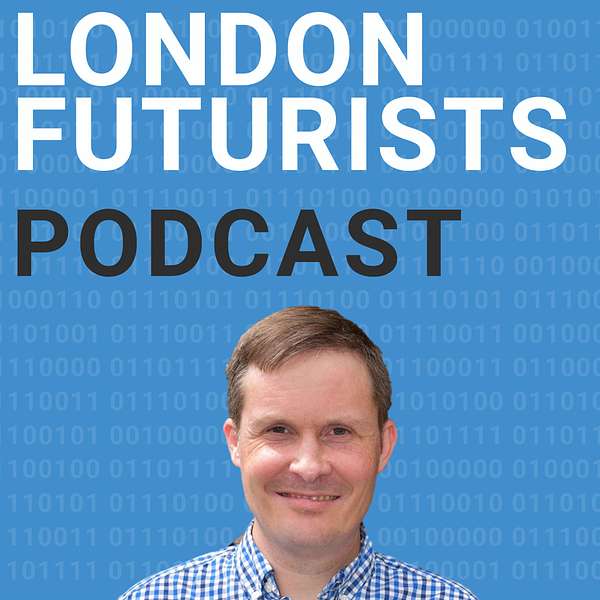
London Futurists
Anticipating and managing exponential impact - hosts David Wood and Calum Chace
Calum Chace is a sought-after keynote speaker and best-selling writer on artificial intelligence. He focuses on the medium- and long-term impact of AI on all of us, our societies and our economies. He advises companies and governments on AI policy.
His non-fiction books on AI are Surviving AI, about superintelligence, and The Economic Singularity, about the future of jobs. Both are now in their third editions.
He also wrote Pandora's Brain and Pandora’s Oracle, a pair of techno-thrillers about the first superintelligence. He is a regular contributor to magazines, newspapers, and radio.
In the last decade, Calum has given over 150 talks in 20 countries on six continents. Videos of his talks, and lots of other materials are available at https://calumchace.com/.
He is co-founder of a think tank focused on the future of jobs, called the Economic Singularity Foundation. The Foundation has published Stories from 2045, a collection of short stories written by its members.
Before becoming a full-time writer and speaker, Calum had a 30-year career in journalism and in business, as a marketer, a strategy consultant and a CEO. He studied philosophy, politics, and economics at Oxford University, which confirmed his suspicion that science fiction is actually philosophy in fancy dress.
David Wood is Chair of London Futurists, and is the author or lead editor of twelve books about the future, including The Singularity Principles, Vital Foresight, The Abolition of Aging, Smartphones and Beyond, and Sustainable Superabundance.
He is also principal of the independent futurist consultancy and publisher Delta Wisdom, executive director of the Longevity Escape Velocity (LEV) Foundation, Foresight Advisor at SingularityNET, and a board director at the IEET (Institute for Ethics and Emerging Technologies). He regularly gives keynote talks around the world on how to prepare for radical disruption. See https://deltawisdom.com/.
As a pioneer of the mobile computing and smartphone industry, he co-founded Symbian in 1998. By 2012, software written by his teams had been included as the operating system on 500 million smartphones.
From 2010 to 2013, he was Technology Planning Lead (CTO) of Accenture Mobility, where he also co-led Accenture’s Mobility Health business initiative.
Has an MA in Mathematics from Cambridge, where he also undertook doctoral research in the Philosophy of Science, and a DSc from the University of Westminster.
London Futurists
Whatever happened to self-driving cars, with Timothy Lee
Self-driving cars has long been one of the most exciting potential outcomes of advanced artificial intelligence. Contrary to popular belief, humans are actually very good drivers, but even so, well over a million people die on the roads each year. Globally, for people between 12 and 24 years old, road accidents are the most common form of death.
Google started its self-driving car project in January 2009, and spun out a separate company, Waymo, in 2016. Expectations were high. Many people shared hopes that within a few years, humans would no longer need to drive. Some of us also thought that the arrival of self-driving cars would be the signal to everyone else that AI was our most powerful technology, and would get people thinking about the technological singularity. They would in other words be the “canary in the coal mine”.
The problem of self-driving turned out to be much harder, and insofar as most people think about self-driving cars today at all, they probably think of them as a technology that was over-hyped and failed. And it turned out that chatbots – and in particular GPT-4 - would be the canary in the coal mine instead.
But as so often happens, the hype was not wrong – it was just the timing that was wrong. Waymo and Cruise (part of GM) now operate paid-for taxi services in San Francisco and Phoenix, and they are demonstrably safer than humans. Chinese companies are also pioneering the technology.
One man who knows much more about this than most is our guest today, Timothy Lee, a journalist who writes the newsletter "Understanding AI". He was previously a journalist at Ars Technica and the Washington Post, and he has a masters degree in Computer Science. In recent weeks, Timothy has published some carefully researched and insightful articles about the state of the art in self-driving cars.
Selected follow-ups:
https://www.UnderstandingAI.org/
Topics addressed in this episode include:
*) The two main market segments for self-driving cars
*) Constraints adopted by Waymo and Cruise which allowed them to make progress
*) Options for upgrading the hardware in a self-driven vehicle
*) Some local opposition to self-driving cars in San Francisco
*) A safety policy: when uncertain, stop, and phone home for advice
*) Support from the State of California - and from other US States
*) Comparing accident statistics: human drivers versus self-driving
*) Why self-driving cars don't require AGI (Artificial General Intelligence)
*) Reasons why self-driving cars cannot be remotely tele-operated
*) Prospects for self-driven freight transport running on highways
*) The company Nuro that delivers pizza and other items by self-driven robots
*) Another self-driving robot company: Starship ("your local community helpers")
*) The Israeli company Mobileye - acquired by Intel in 2017
*) Friction faced by Chinese self-driving companies in the US and elsewhere
*) Different possibilities for the speed at which self-driving solutions will scale up
*) Potential social implications of wider adoption of self-driving solutions
*) Consequences of fatal accidents
*) Dangerous behaviour from safety drivers
*) The special case of Tesla FSD (assisted "Full Self-Driving") and Elon Musk
*) The future of recreational driving
*) An invitation to European technologists
Music: Spike Protein, by Koi Discovery, available under CC0 1.0 Public Domain Declaration
Elevate how you lead with insight from today’s most influential executives.
Listen on: Apple Podcasts Spotify

